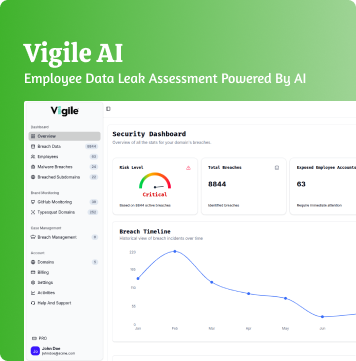
In cybersecurity, timing is everything. The faster you detect a breach, the smaller the impact. Yet too many organizations only discover exposed credentials after attackers have already logged in, downloaded data, or launched phishing campaigns.
The harsh truth is simple: hackers are constantly scanning for leaked credentials; you should be doing the same. Proactive credential monitoring is one of the most powerful, cost-effective ways to prevent compromise before it happens.
Why Credential Monitoring Matters
When usernames and passwords are leaked, through phishing, malware, or a third-party breach, they often end up for sale or trade on dark web marketplaces. Attackers then test those credentials on email, VPN, and cloud systems using automated scripts.
Without early detection, a single exposed login can lead to widespread infiltration. That’s where credential monitoring and breach detection come in. These processes alert you when your corporate email domains, employee accounts, or system credentials appear in breach data or hacker forums.
Think of it as a digital early-warning system; one that gives your security team time to respond before damage occurs.
Step 1: Know Where Your Credentials Could Appear
Hackers share and sell data across multiple channels; dark web markets, Telegram groups, and paste sites. Effective monitoring means scanning these sources continuously.
You can use:
- Dark web intelligence tools to detect mentions of your company domain.
- Breach databases that track known leaks and exposures.
- Managed monitoring platforms (like Vigile.AI’s AI-driven dark web intelligence system) that combine automation with human validation for accuracy.
Step 2: Prioritize and Respond Quickly
When leaked data is found, speed matters. Immediately:
- Identify affected accounts.
- Force password resets and revoke tokens.
- Review recent login activity for anomalies.
If you see patterns like repeated exposures from the same department or vendor; that’s a signal your cyber hygiene and training policies need reinforcement.
Step 3: Strengthen Your Security Best Practices
Credential leaks often reveal weak internal practices rather than advanced attacks. Here’s how to stay ahead:
- Use Multi-Factor Authentication (MFA): Make stolen passwords useless.
- Rotate and harden passwords: Enforce strong policies and eliminate reuse.
- Educate employees: Most breaches begin with human error, not zero-days.
- Implement continuous testing: Regular security assessments reveal vulnerabilities before attackers do.
Strong cyber hygiene isn’t a one-time effort – it’s a culture.
Step 4: Automate and Outsource Where Possible
Manual monitoring can’t keep up with how fast breach data spreads. Partnering with a specialized security provider ensures 24/7 surveillance and actionable insights.
Platforms like Vigile.AI combine advanced AI-powered monitoring with human threat intelligence to help you detect exposed credentials, validate risks, and strengthen your defenses — all before attackers’ strike.
Don’t Let Hackers Be the First to Know
The question isn’t whether your credentials will appear in a breach – it’s whether you’ll find them before someone else does. At Vigile.AI, we empower organizations to stay ahead through continuous credential monitoring, dark web intelligence, and proactive defense solutions.
Protect your company today, visit Vigile.AI to start monitoring your credentials before hackers do.



